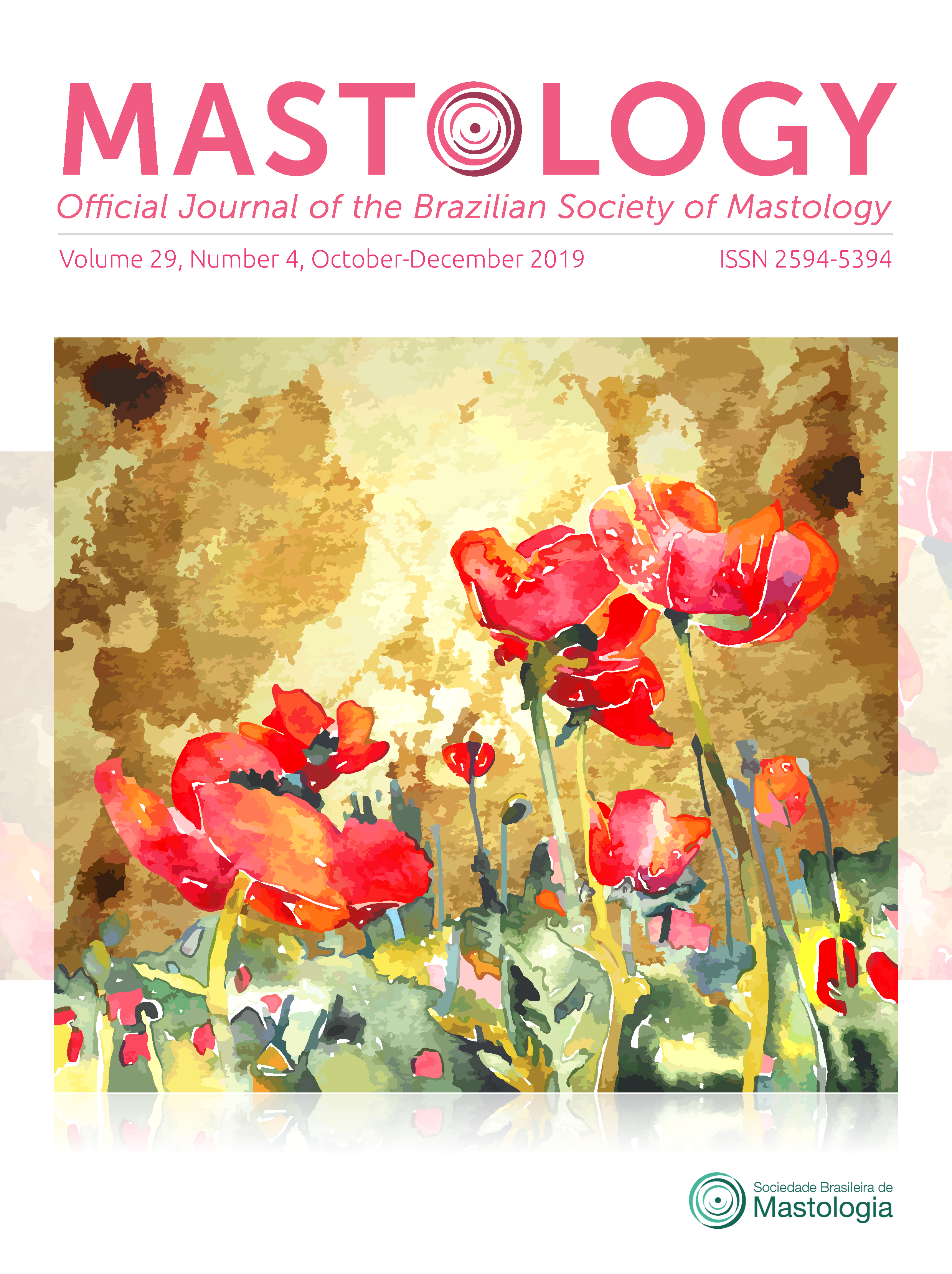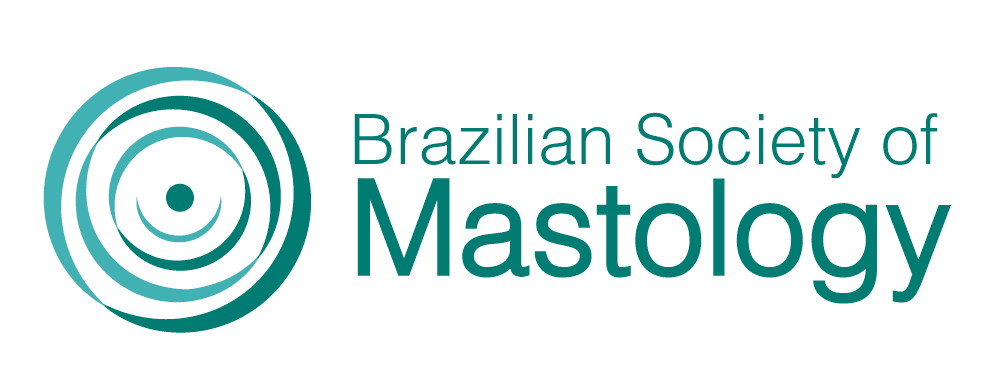Linfoma anaplásico de grandes células associado a implante na síndrome de Li-Fraumeni
relato de caso baseado em revisão de literatura
Palavras-chave:
linfoma, síndrome de Li-Fraumeni, implantes de mama, neoplasias da mama, linfoma anaplásico de células grandesResumo
O linfoma anaplásico de células grandes associado ao implante mamário é uma doença rara relacionada ao seroma crônico em torno dos implantes mamários. O linfoma anaplásico de células grandes associado ao implante foi recentemente reconhecido pela Organização Mundial de Saúde como um tipo de linfoma não-Hodgkin de células T da mama. As principais características incluem o seroma crônico que se desenvolve um ano depois da cirurgia da mama, com sintomas como dor na mama, inchaço, hiperemia da pele e um nódulo ou massa da mama. A síndrome de Li-Fraumeni está associada à mutação da linha germinativa no TP53 e aumenta o risco de desenvolvimento de muitos tipos de câncer, incluindo neoplasias mamárias e hematológicas. Relatamos um caso de uma mulher de 56 anos de idade com Síndrome de Li-Fraumeni e um histórico de câncer de mama submetido a uma mastectomia para tratar câncer de mama e mastectomia profilática contralateral poupadora de mamilo seguida de reconstrução bilateral de implantes mamários com implantes de silicone texturizados. Esta paciente desenvolveu linfoma anaplásico de células grandes associado ao implante mamário sete anos depois. Foi realizada uma revisão da literatura sobre uma abordagem multidisciplinar para essa condição.
Downloads
Referências
Keech JA Jr., Creech BJ. Anaplastic T-cell lymphoma in proximity to a saline-filled breast implant. Plast Reconstr Surg. 1997;100(2):554-5. https://doi.org/10.1097/00006534-199708000-00065
Clemens MW, Horwitz SM. NCCN Consensus Guidelines for the Diagnosis and Management of Breast Implant- Associated Anaplastic Large Cell Lymphoma. Aesthet Surg J. 2017;37(3):285-9. https://doi.org/10.1093/asj/sjw259
Doren EL, Miranda RN, Selber JC, Garvey PB, Liu J, Medeiros LJ, et al. U.S. epidemiology of breast implant-associated anaplastic large cell lymphoma. Plast Reconstr Surg. 2017;139(5):1042-50. https://doi.org/10.1097/PRS.0000000000003282
Mehta-Shah N, Clemens MW, Horwitz SM. How I treat breast implant-associated anaplastic large cell lymphoma. Blood. 2018;132(18):1889-98. https://doi.org/10.1182/blood-2018-03-785972
Rastogi P, Deva AK, Prince HM. Breast Implant-Associated Anaplastic Large Cell Lymphoma. Curr Hematol Malig Rep. 2018;13(6):516-24. https://doi.org/10.1007/s11899-018-0478-2
Malkin D. Li-Fraumeni syndrome. Genes Cancer. 2011;2(4):475‑84. https://doi.org/10.1177/1947601911413466
Amadou A, Waddington Achatz MI, Hainaut P. Revisiting tumor patterns and penetrance in germline TP53 mutation carriers: temporal phases of Li-Fraumeni syndrome. Curr Opin Oncol. 2018;30(1):23-9. https://doi.org/10.1097/CCO.0000000000000423
Valdez JM, Nichols KE, Kesserwan C. Li-Fraumeni syndrome: a paradigm for the understanding of hereditary cancer predisposition. Br J Haematol. 2017;176(4):539-52. https://doi.org/10.1111/bjh.14461
Clemens MW, Medeiros LJ, Butler CE, Hunt KK, Fanale MA, Horwits S, et al. Complete surgical excision is essential for the management of patients with breast implant-associated anaplastic large-cell lymphoma. J Clin Oncol. 2016;34(2):160-8. https://doi.org/10.1200/JCO.2015.63.3412
Loch-Wilkinson A, Beath KJ, Knight RJW, Wessels WLF, Magnusson M, Papadopoulos T, et al. Breast implant‑associated anaplastic large cell lymphoma in Australia and New Zealand: high-surface-area texture implants are associated with increased risk. Plast Reconstr Surg. 2017;140(4):645-54. https://doi.org/10.1097/PRS.0000000000003654
Hu H, Jacombs A, Vickery K, Merten SL, Pennington DG, Deva AK. Chronic biofilm infection in breast implants is associated with an increased T-cell lymphocytic infiltrate: implications for breast implant-associated lymphoma. Plast Reconstr Surg. 2015;135(2):319-29. https://doi.org/10.1097/ PRS.0000000000000886
Miranda RN, Aladily TN, Prince HM, Kanagal-Shamanna R, de Jong D, Fayad LE, et al. Breast implant-associated anaplastic large-cell lymphoma: long-term follow-up of 60 patients. J Clin Oncol. 2014;32(2):114-20. https://doi.org/10.1200/JCO.2013.52.7911
Laurent C, Delas A, Gaulard P, Haioun C, Moreau A, Xerri L, et al. Breast implant-associated anaplastic large cell lymphoma: two distinct clinicopathological variants with different outcomes. Ann Oncol. 2016;27(2):306-14. https://doi.org/10.1093/annonc/mdv575
Mai PL, Best AF, Peters JA, DeCastro RM, Khincha PP, Loud JT, et al. Risks of first and subsequent cancers among TP53 mutation carriers in the National Cancer Institute Li- Fraumeni syndrome cohort. Cancer. 2016;122(23):3673-81. https://doi.org/10.1002/cncr.30248
Lee YS, Filie A, Arthur D, Fojo AT, Jaffe ES. Breast implantassociated anaplastic large cell lymphoma in a patient with Li- Fraumeni syndrome. Histopathology. 2015;67(6):925-7. https://doi.org/10.1111/his.12737
Giacomazzi J, Graudenz MS, Osorio SABT, Koehler-Santos P, Palmero EI, Zagonel-Oliveira M, et al. Prevalence of the TP53 p.R337H mutation in breast cancer patients in Brazil. PLoS One. 2014;9(6):e99893. https://doi.org/10.1371/journal.pone.0099893
Lee YS, Filie A, Arthur D, Fojo AT, Jaffe ES. Breast implantassociated anaplastic large cell lymphoma in a patient with Li- Fraumeni syndrome. Histopathology. 2015;67(6):925-7. https://doi.org/10.1111/his.12737
Cheson BD, Fisher RI, Barrington SF, Cavalli F, Schwartz LH, Zucca E, et al. Recommendations for initial evaluation, staging, and response assessment of Hodgkin and non- Hodgkin lymphoma: the Lugano classification. J Clin Oncol. 2014;32(27):3059-67. https://doi.org/10.1200/JCO.2013.54.8800
Clemens MW, Brody GS, Mahabir RC, Miranda RN. How to Diagnose and Treat Breast Implant-Associated Anaplastic Large Cell Lymphoma. Plast Reconstr Surg. 2018;141(4):586e-599e. https://doi.org/10.1097/PRS.0000000000004262
Downloads
Publicado
Como Citar
Edição
Seção
Licença
Copyright (c) 2019 Marina Sonagli, Camila Souza Guatelli, Maria Nirvana da Cruz Formiga, Joel Abdala Junior, Almir Galvão Vieria Bittencourt, Fabiana Baroni Makdissi

Este trabalho está licenciado sob uma licença Creative Commons Attribution 4.0 International License.







